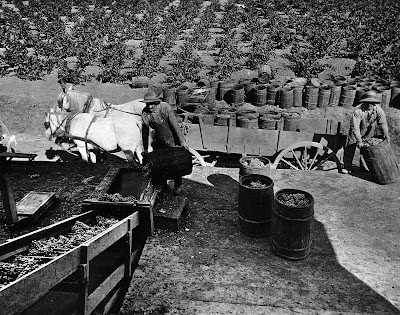Leland Stanford is well known as a railroad tycoon, senator for and governor of California, and founder of the university that bears his name. What's perhaps not as well known is the fact that he owned a number of vineyards and wineries. The great Vina winery in Tehama County encompassed over 55,000 acres with around 13,400 acres planted with vines, making it the largest vineyard in the world at the time, though the quality was never great and mostly went to produce brandy. In addition there were vineyards planted on the grounds of the university where the Stanford shopping mall now stands and a small winery based in the Stanford Barn supplied cheap wine to locals until it was closed in 1893. (Source:
stanfordalumni.org). Stanford also owned a more successful winery in the east bay.
In 1850 Clement Colombet purchased 640 acres of the 9,564 acre Agua Caliente land grant from Fulgencia Higuera. The land included several natural volcanic springs, and Colombet soon established the Warm Springs Hotel & Spa. He also planted vineyards and made some award-winning wines. The property was badly damaged in the great
earthquake of 1868.

Colombet retired to San Jose and sold the resort to Alfred Cohen, owner of the San Francisco and Alameda Railroad. Cohen rebuilt the main building and renamed it the Cohen Hotel, with the intention of extending his railroad to the resort. However the following year he merged his company with Leland Stanford's Central Pacific railway and in the process sold the property to him. (Image, undated, from the US Library of Congress).
Leland's brother Josiah and his family ran the property, extending the vineyards and establishing a successful winery and distillery. They soon achieved a reputation for excellent wines. At its peak, annual production from the Stanford Winery was around 250,000 gallons.

Following the death of his son Leland Jr. in 1884, Stanford took the decision to build the University in his memory. Leland deeded the Warm Spring property to Josiah who, together with his son, continued to operate it until the vineyards were attacked by phylloxera in 1917. Following prohibition the property was sold and for a while became a regular horse ranch. In 1945 the Weibel family bought it and set about restoring the vineyards and producing sparkling wines. Following an application by the Weibel family the property was designated California Historical Landmark No. 642 in 1958. (Photo by
Mark Heringer).
By the mid 1990s the value of the land for housing was so great that the Weibels sold the property to developers and moved to Hopland, in Mendocino county. There were moves to preserve the Cohen Hotel, but it was destroyed by fire in 1992. All that remains of the winery and vineyards is a single building and a number of street names: Stanford Avenue, Vine Hill Terrace, Weibel Avenue, Vineyard Avenue and Vintners Circle. The building is locked and, though it appears in excellent condition, is not currently in use or open to the public.

Unfortunately the landmark plaque was stolen around a year ago during a spate of bronze thefts in the area. Although the California State Office of Historic Preservation approves and issues the plaques they do not pay for them; the cost of a replacement is around $3,000 and must be borne by the applicant. The city of Fremont is aware of the loss and intends to have it replaced, but in the current financial crisis the funds are not available to do so. It is to be hoped that the money can one day be found to replace the marker, recognising this location's significance in the history of Californian viticulture.
View Larger Map











 Following the death of his son Leland Jr. in 1884, Stanford took the decision to build the University in his memory. Leland deeded the Warm Spring property to Josiah who, together with his son, continued to operate it until the vineyards were attacked by phylloxera in 1917. Following prohibition the property was sold and for a while became a regular horse ranch. In 1945 the Weibel family bought it and set about restoring the vineyards and producing sparkling wines. Following an application by the Weibel family the property was designated California Historical Landmark No. 642 in 1958. (Photo by Mark Heringer).
Following the death of his son Leland Jr. in 1884, Stanford took the decision to build the University in his memory. Leland deeded the Warm Spring property to Josiah who, together with his son, continued to operate it until the vineyards were attacked by phylloxera in 1917. Following prohibition the property was sold and for a while became a regular horse ranch. In 1945 the Weibel family bought it and set about restoring the vineyards and producing sparkling wines. Following an application by the Weibel family the property was designated California Historical Landmark No. 642 in 1958. (Photo by Mark Heringer).
 The quality of Sonnie Boy grapes was so good that despite Prohibition the Madrone winery expanded and additional vineyards were planted in Santa Clara and San Benito counties. The family acquired a winery and a number of vineyards in Fresno, including the Las Palmas Vineyard which dated back to the 17th Century. Following Repeal the Madrone and Fresno wineries continued to expand and additional vineyards planted in the foothills of San Benito County, with sweet wines being produced in Fresno and quality table wines in the Santa Clara valley.
The quality of Sonnie Boy grapes was so good that despite Prohibition the Madrone winery expanded and additional vineyards were planted in Santa Clara and San Benito counties. The family acquired a winery and a number of vineyards in Fresno, including the Las Palmas Vineyard which dated back to the 17th Century. Following Repeal the Madrone and Fresno wineries continued to expand and additional vineyards planted in the foothills of San Benito County, with sweet wines being produced in Fresno and quality table wines in the Santa Clara valley.